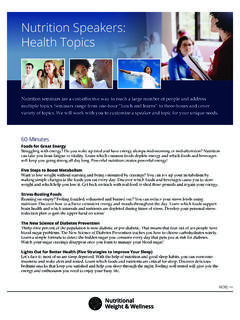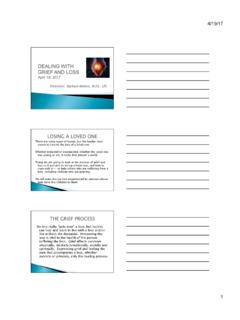Transcription of What is a Processed Food? You Might Be Surprised!
1 Understanding Our food Communications Tool Kit International food Information Council Foundation September 2010 Informational Handout 1 of 5 Page 1 what comes to mind when you think of a Processed food ? You re right if you think of items such as cookies, snack chips and carbonated drinks. But you Might be surprised to learn that most foods we eat are on to get the facts about Processed foods and answers to some common questions about them. Processed Foods DefinedFood processing is any deliberate change in a food that occurs before it s available for us to eat. It can be as simple as freezing or drying food to preserve nutrients and freshness, or as complex as formulating a frozen meal with the right balance of nutrients and ingredients. A few examples of Processed foods include:Canned and frozen fruits and vegetablesPackaged foods labeled natural or organic, such as cereals, fresh meat and poultry, and jarred baby foodsFoods with health and nutrition claims on the label, such as may reduce risk of heart disease, low in fat or high in calcium Foods fortified with nutrients such as fiber, vitamin D and omega-3 fatty acidsFoods prepared in quick-service and fine-dining restaurants, cafeterias and food courts, sports arenas, coffee shops and other locations The Prehistoric Origins of food ProcessingThe era of food processing began about 2 million years ago when our distant ancestors put flame to food and discovered cooking.
2 After that came fermenting, drying, preserving with salt, and other primitive forms of food processing. This ultimately led to the modern food processing methods of today, which give us an abundant, safe, convenient, affordable and nutritious food supply. what is a Processed Food? You Might Be surprised ! Understanding Our food Communications Tool Kit International food Information Council Foundation September 2010 Informational Handout 1 of 5 Page 2 The Continuum of Processed FoodsProcessed foods can be placed on a continuum that ranges from minimally Processed items to more complex preparations that combine ingredients such as what is a Processed Food? You Might Be Surprised! sweeteners, spices, oils, flavors, colors, and preservatives, with many variations in between. The chart below gives some common examples.
3 Foods that require little processing or production (also called minimally Processed ). Foods Processed to help preserve and enhance nutrients and freshness of foods at their that combine ingredients such as sweeteners, spices, oils, flavors, colors, and preservatives to improve safety and taste and/or add visual appeal. (Does not include ready-to-eat foods listed below.) Ready-to-eat foods needing minimal or no preparation. Foods packaged to stay fresh and save timeWashed and packaged fruits and vegetables; bagged salads; roasted and ground nuts and coffee beansCanned tuna, beans and tomatoes; frozen fruits and vegetables; pureed and jarred baby foodsSome packaged foods, such as instant potato mix, rice, cake mix, jarred tomato sauce, spice mixes, dressings and sauces, and gelatinBreakfast cereal, flavored oatmeal, crackers, jams and jellies, nut butters, ice cream, yogurt, garlic bread, granola bars, cookies, fruit chews, rotisserie chicken, luncheon meats, honey-baked ham, cheese spreads, fruit drinks and carbonated beveragesPrepared deli foods and frozen meals, entr es, pot pies and pizzasType of FoodExamplesIn this example, corn can be Processed to create many different foods and ingredients that consumers enjoy.
4 Certain types of corn grown in a field can be picked and eaten off the cob. Or, corn kernels can be removed from the cob and preserved in cans or jars for enjoyment later. Popcorn is a special type of corn that is grown to pop! Popcorn kernels are dried on the cob, removed, popped From Farm to Fork: How One food Provides Many Optionsand packaged as popcorn snacks or as kernels that can be popped at home. To make tortilla chips, manufacturers mix ground corn and water to form a dough (masa) which is then baked or fried into a chip. Corn syrup is made from refined corn starch and is used as an ingredient in making desserts, in sauces and relishes, and to sweeten certain foods and Understanding Our food Communications Tool Kit International food Information Council Foundation September 2010 Informational Handout 1 of 5 Page 3 Five Common Questions about Processed FoodsQ: Are Processed foods safe?
5 A: Yes, in fact processing foods often makes them safer. For example, heating foods helps remove harmful bacteria. Pasteurization is a common heating process applied to milk to kill harmful organisms. Canning and freezing foods such as meats, fruits and vegetables helps them to stay fresher longer. Q: Do Processed foods cause obesity? A: Most nutrition experts agree that no one type of food causes obesity obesity results from consuming more calories than the body uses, regardless of where the calories come from. To maintain a healthy weight, it s important to balance calories consumed with regular physical activity and to only occasionally enjoy single portions of treats such as fried foods, snack chips, desserts, candy, fruit drinks and soft drinks. Some Processed foods may actually aid with weight management because they include ingredients that reduce the calorie content of foods, such as low-calorie is a Processed food ?
6 You Might Be Surprised! Q: Do Processed foods lack nutrition? A: Because Processed foods include such a wide range of products, their nutritional values vary widely, too. For instance, frozen vegetables can be more nutrient-rich than fresh because they are picked and frozen at their nutritional peak. Furthermore, Processed foods that are fortified with vitamins, minerals or other nutrients can help people reach the recommended intake levels for those nutrients. An example is orange juice fortified with calcium and vitamin D. Some Processed foods, such as fried foods, desserts and candy, supply calories but few other : Are Processed foods expensive? A: Again, the wide range of choices means a wide range of prices. For instance, buying frozen strawberries Might be less expensive than buying fresh strawberries out of season, but preparing tomato sauce with home-grown tomatoes in season Might be less expensive than buying jarred tomato sauce.
7 Q: Are any Processed foods natural? A: The food and Drug Administration (FDA) doesn t define the term natural on food labels, but generally allows the term if the food doesn t contain added colors, artificial flavors, or other synthetic substances. According to that definition, numerous Processed foods could be considered natural. These include many fruit and vegetable products, grain and dairy products, and meat, poultry and fish products. A few examples are packaged cooked and uncooked chicken, potato chips, rice, frozen spinach and jarred more information about modern food production and processing, please visit: Connecticut Avenue NW Suite 430 Washington, DC


